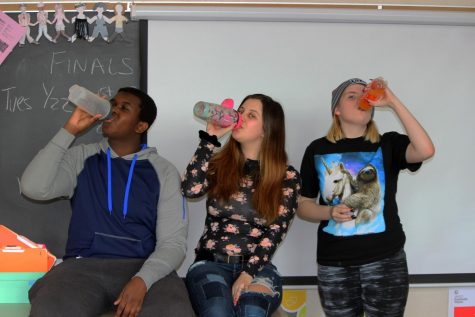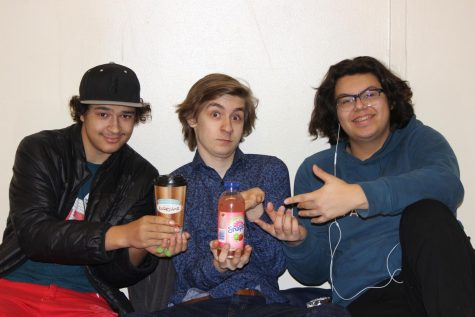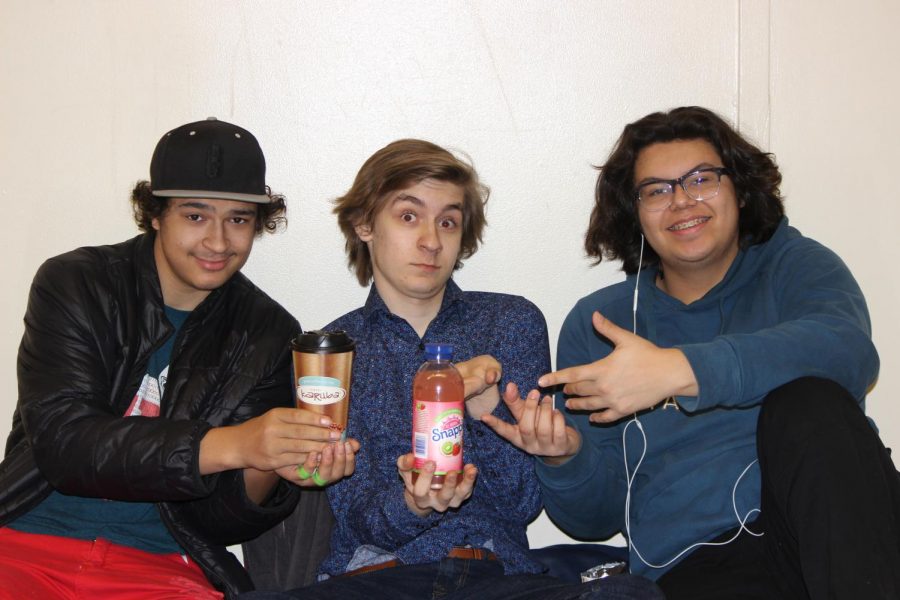Yearbook Design and Publishing: Between the Pages
Junior James Hayes, with a Kwik Trip coffee, joins juniors Louie Kingslien and Eli Fox Baker as they model their Snapple drink from the Tower Store.
I joined Yearbook class without much knowledge on how to use Adobe InDesign. I had no idea what went into making the yearbook and the crazy edits. After being in Yearbook for an entire school year, I learned a lot about the class that most people probably don’t know. With that being said, I would like to share my knowledge.
The entire process begins with a yearbook theme. This year’s was “Purgolder Perspectives.” Once we had the theme, we discussed our ideas on what to make the yearbook cover look like. This involved creating rough ideas in Adobe InDesign, and explaining our ideas in front of the class. Then we voted on which idea we liked the most, and revamped it into something that looks appealing.
The next step was making the spreads. The freshmen, sophomore, junior and senior photos were placed in the pages, and the names were later checked and double-checked for accuracy (especially after the 2017-2018 yearbook). We also shared out ideas for Student Life spreads and decided which ones to work on. We go out and take pictures to add to those spreads, and then edit the layout of the page. It takes a lot of fixing to get something that is informative and looks satisfactory.
We’re lucky to have a studio across the hall from our class, and we’ve used it several times to take pictures of yearbook staff members and people from around the school for the senior superlatives. Sometimes we took pictures against a simple background if the photo does not require editing, or against a green-screen if the subjects will be placed against a different background.
Editing the yearbook is done predominantly with Adobe InDesign, although some of the pictures in the yearbook are edited with Adobe Photoshop. Once the page layouts are completed, they are given a couple final looks before being ready to send to the yearbook company.
Every spread you see in the yearbook – the Lifestyles pages, winter sports pages, fine arts pages, the spring sports pages, and the index, just to name a few – were all edited and finished by mini-deadlines in order for them to be turned into the yearbook company, which is located in a different state. These pages will then be bound together to create many copies of the final 224-page 2018-2019 yearbook. If there are any changes that need to be made after the pages are turned in, it will cost $50 a page to make them, but only before April 21. After that date, no changes can be made.
As simple as the yearbook-making process seems, Yearbook Design and Publishing can be stressful at times because of the mini-deadlines. Therefore, if a person ever needs help, they are welcome to ask one of their peers or their teacher for any assistance. Not everyone in class will know how to use all Adobe programs available to them, so if you have any knowledge of the Adobe programs we do not use much, sharing that knowledge will undoubtedly be essential.

Seniors Ousman Jabang and Eliza Beslic stay hydrated with their water bottles while senior Angelina Holden sips an orange Fanta.

Junior James Hayes, with a Kwik Trip coffee, joins juniors Louie Kingslien and Eli Fox Baker as they model their Snapple drink from the Tower Store.

Eric is a senior on the Tower Tales Yearbook staff and the mastermind behind the TTV announcements.
